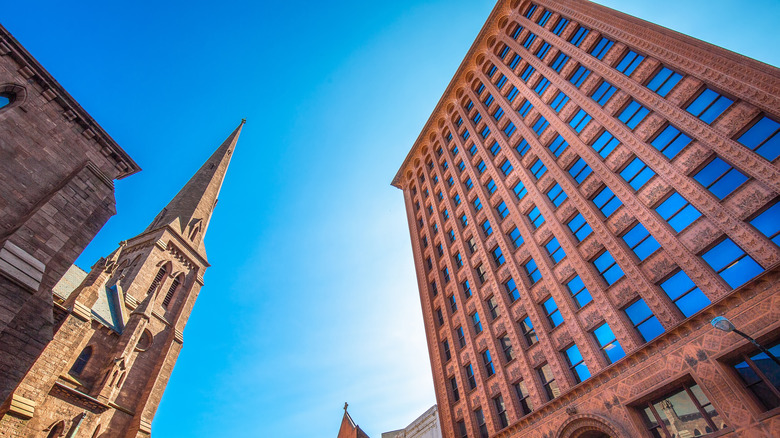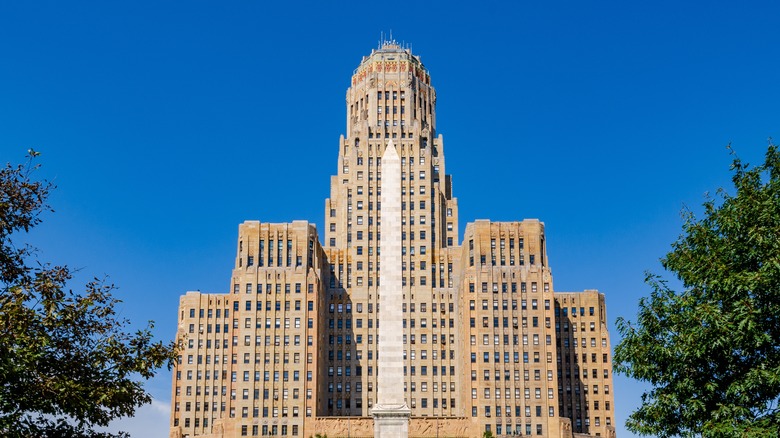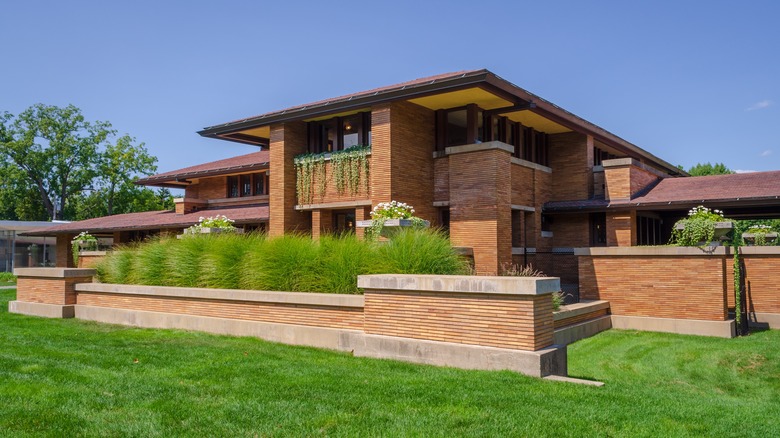The Underrated City In Western New York Full Of Unique And Iconic Architectural Treasures
Peering out toward Canada on the shores of Lake Erie, Buffalo is perhaps best known as the home of buffalo wings and for the heavy snowfalls that blanket the area every winter. But for architecture buffs, the city is a treasure trove of remarkably well-preserved 19th and early 20th-century buildings. During that period, Buffalo attracted renowned architects, including Frank Lloyd Wright, H.H. Richardson, and Frederick Law Olmsted, whose designs came to define an entirely new, home-grown American style of architecture.
Buffalo began to thrive after the completion of the Erie Canal in 1925. Workers flocked to the area, and over the next century, industry boomed in the shipyards, railroads, and mills producing flour, iron, and steel. This economic boom led to Buffalo becoming one of America's wealthiest cities during the Gilded Age, and all of that money — combined with an openness to architectural experimentation — made Buffalo attractive to designers.
Buffalo is lovingly restoring many of its grandest buildings, bringing them back to life with a new purpose. You don't need to be an expert to appreciate the city's rich architectural landscape. All you need is a willingness to explore, the ability to crane your neck and peer upward from street level, and a good pair of sneakers to get you around. Whether you add Buffalo to a New York road trip or make it a destination in its own right, you won't be disappointed.
Downtown Buffalo's architectural treasures
Wandering around the center of Buffalo, you'll have the chance to enjoy stunning architecture at every turn. Many buildings are decorated with elaborately carved animals, columns, scrolls, and even faces, so simply looking upward as you walk will open your eyes to the city's fantastic architecture. Start your exploration of the downtown area at the Art Deco City Hall in Niagara Square. The 32-story building was completed in 1931 and is the perfect place to get a sense of Buffalo's grand past. City Hall is decorated inside and out with figures, murals, and sculpted elements. Take a tour to see the fabulous stained-glass ceiling on the 13th floor or admire the views over Lake Erie from the 25th-floor observation deck.
A short walk will take you to the Guaranty Building and St. Paul's Episcopal Cathedral, which sit opposite each other on what has to be one of Buffalo's most impressive intersections. The Guaranty Building was designed by Louis Sullivan (and Dankmar Adler), "the father of the skyscraper," whose style inspired Frank Lloyd Wright. The building's striking terracotta facade is beautifully decorated. Across the road, St. Paul's is a Gothic Revival showpiece of spires and pitched rooves.
There are so many more buildings to enjoy in the downtown area, but our final don't-miss pick is the Ellicott Square Building. This vast Italian Renaissance-style office building is a masterpiece of granite and terracotta on the outside. Inside, it boasts a gorgeous mosaic floor in the lobby and a glass-roofed courtyard with a mural in the center.
Explore more of Buffalo's architecture
We promised you Frank Lloyd Wright, and boy, does Buffalo deliver. The architect's most famous work in the city is the Darwin D. Martin House Complex, a must-visit historic mansion some 4 miles north of downtown. This sprawling complex showcases Lloyd Wright's Prarie design style with plenty of glass — including the famous Tree of Life design — and an overhanging roof. You can book a tour of the house to explore inside. Frank Lloyd Wright designed many other buildings in Buffalo, including Graycliff, a magnificent summer estate overlooking Lake Erie.
Drive through picturesque Delaware Park on your way to your next stop. The park was designed by Frederick Law Olmsted and Calvert Vaux, who also designed New York's Central Park. They envisioned Delaware as a country park, complete with a boating lake and the Japanese and Rose Gardens. As you pop out of the park, you'll come upon the AKG Art Museum (formerly the Albright-Knox Gallery). The Greek Revival-style building's columned front is beautiful, and the gallery contains works by Monet, Picasso, and Rodin.
Your final stop is at the nearby former Buffalo State Asylum for the Insane. Now called the Richardson Olmsted Complex, the former psychiatric hospital was built in the 1870s. H. H. Richardson designed the Romanesque buildings — visitors love the central building's two towers, which lend it the appearance of a castle. Olmsted and Vaux designed the scenic, calming grounds. Buffalo might get overlooked in favor of the tourist traps at nearby Niagara Falls, but American architecture is at its best in the Queen City.


